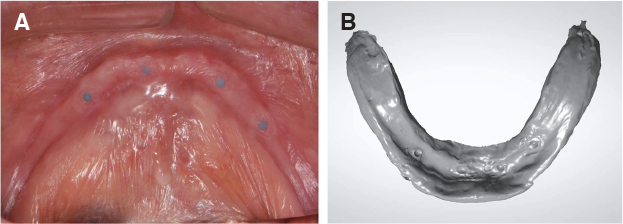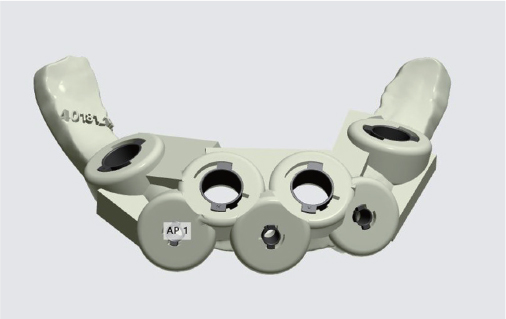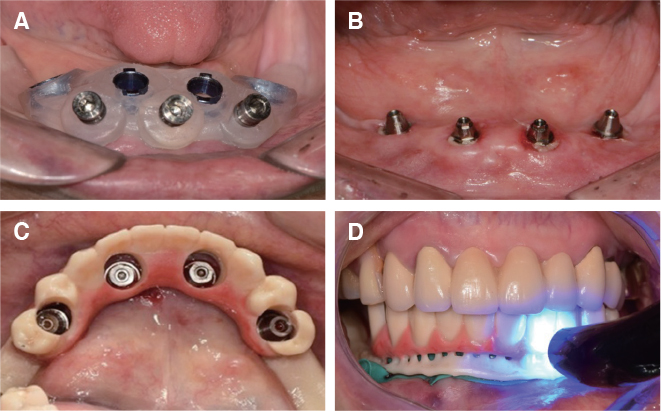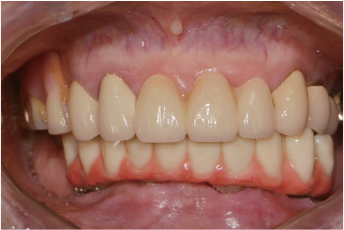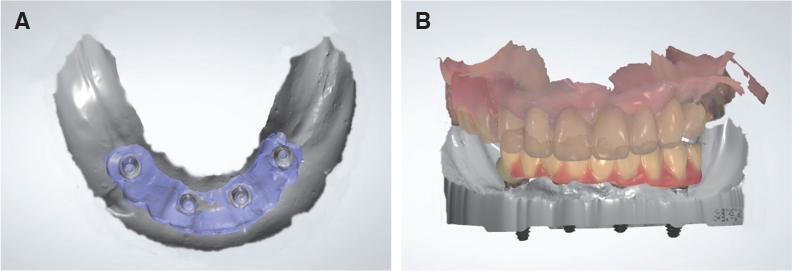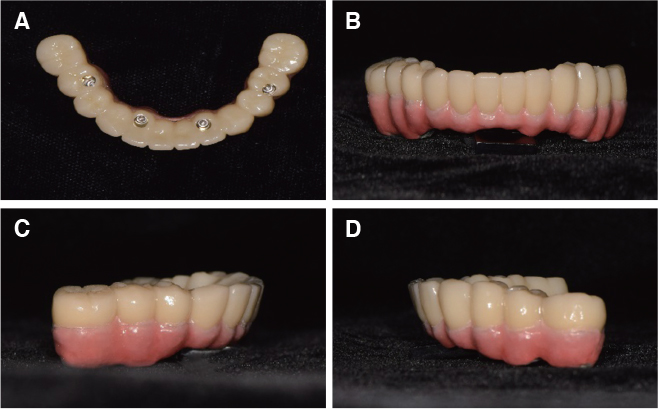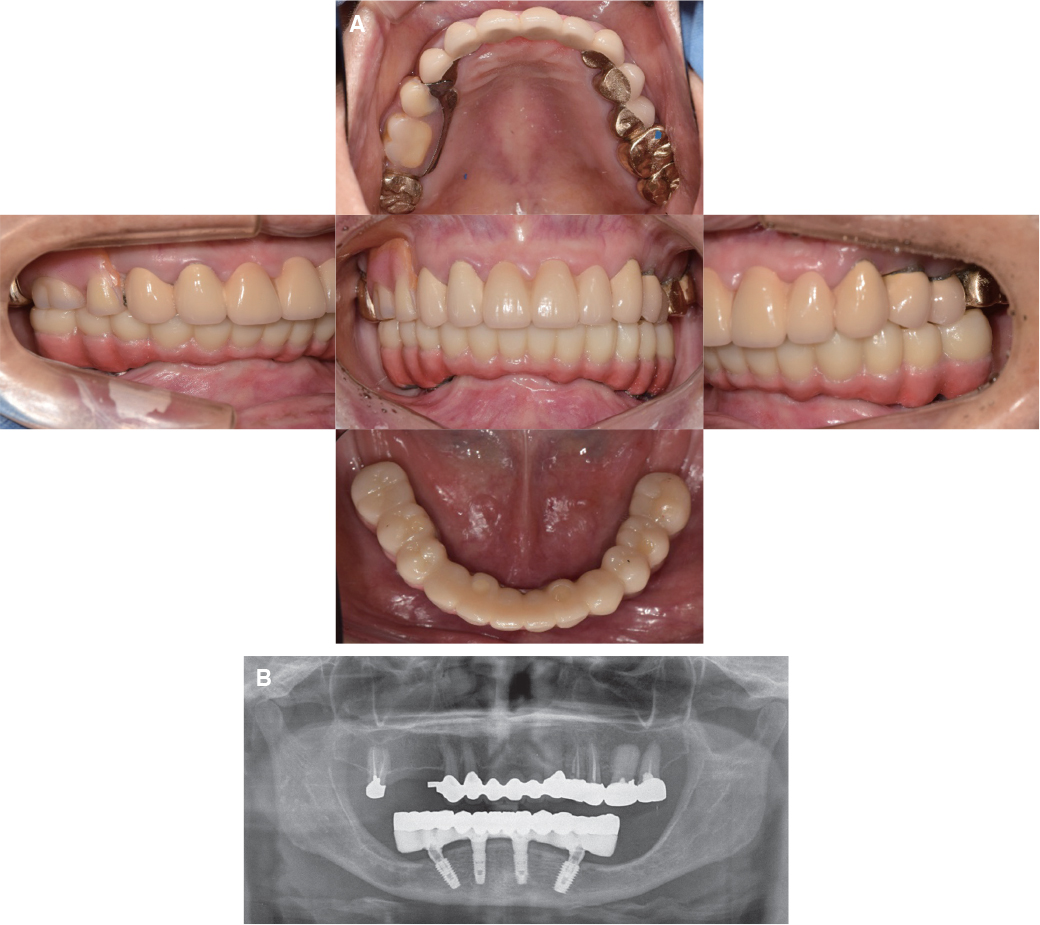J Korean Acad Prosthodont.
2018 Oct;56(4):330-337. 10.4047/jkap.2018.56.4.330.
All-on-4 implant restoration with full-digital system preserving existing occlusion: A case report
- Affiliations
-
- 1Department of Prosthodontics, Wonju College of Medicine, Yonsei University, Wonju, Republic of Korea. smj3@yonsei.ac.kr
- 2Department of Oral and Maxillofacial Surgery, Wonju College of Medicine, Yonsei University, Wonju, Republic of Korea.
- KMID: 2424034
- DOI: http://doi.org/10.4047/jkap.2018.56.4.330
Abstract
- In edentulous patients, implant - supported fixed prosthesis treatment has been proved to be useful, but involves complex treatment process. On the other hand, in the modern dentistry, digital technology has been developed day by day and it has expanded its range to the implant restoration of edentulous patients. In this case, a digital system was used for all stages of diagnosis, surgery, design and fabrication of provisional implants fixed prosthesis restoration in 66-year-old mandibular edentulous patients. In the preoperative diagnosis stage, a provisional restoration was designed based on the mucosal scan using the intraoral scanner and the stable occlusion of prefabricated complete denture of the patient. After flapless implant surgery using the surgical guide, the prefabricated interim restoration was connected to the implant and used as immediate provisional restoration. The final restoration was designed and fabricated by transferring the vertical dimension and the centric relation of the provisional restoration with stable occlusion using digital technology. We report a simple protocol of implant treatment in edentulous patients by using digital techniques to preserve the patient's vertical dimension and occlusion.
MeSH Terms
Figure
Reference
-
1. Wyatt CC. The effect of prosthodontic treatment on alveolar bone loss: a review of the literature. J Prosthet Dent. 1998; 80:362–366.
Article2. Kopp CD. Brånemark osseointegration. Prognosis and treatment rationale. Dent Clin North Am. 1989; 33:701–731.3. Zarb GA, Schmitt A. The longitudinal clinical effectiveness of osseointegrated dental implants: the Toronto Study. Part II: The prosthetic results. J Prosthet Dent. 1990; 64:53–61.
Article4. Joda T, Brägger U. Digital vs. conventional implant prosthetic workflows: a cost/time analysis. Clin Oral Implants Res. 2015; 26:1430–1435.
Article5. Papaspyridakos P, Gallucci GO, Chen CJ, Hanssen S, Naert I, Vandenberghe B. Digital versus conventional implant impressions for edentulous patients: accuracy outcomes. Clin Oral Implants Res. 2016; 27:465–472.
Article6. Choi BH, Jeong SM. Digital flapless implantology. 1st ed. Seoul: Jisung Publishing;2015.7. Tallgren A. The continuing reduction of the residual alveolar ridges in complete denture wearers: a mixed-longitudinal study covering 25 years. J Prosthet Dent. 1972; 27:120–132.
Article8. Zarb G, Bolender C. Prosthodontic treatment for edentulous patients. 12th ed. St. Louis: Mosby;2004.9. Wismeijer D, van Waas MA, Kalk W. Factors to consider in selecting an occlusal concept for patients with implants in the edentulous mandible. J Prosthet Dent. 1995; 74:380–384.
Article10. Ting-Shu S, Jian S. Intraoral digital impression technique: A review. J Prosthodont. 2015; 24:313–321.
Article11. Ender A, Attin T, Mehl A. In vivo precision of conventional and digital methods of obtaining complete-arch dental impressions. J Prosthet Dent. 2016; 115:313–320.
Article12. Lee JH. Improved digital impressions of edentulous areas. J Prosthet Dent. 2017; 117:448–449.
Article
- Full Text Links
- Actions
-
Cited
- CITED
-
- Close
- Share
- Similar articles
-
- A case report of single crown restoration using an intraoral scanner for occlusal evaluation
- All-on-6 implant fixed prosthesis restoration with fulldigital system on edentulous patient: A case report
- Full Mouth Rehabilitation with Modeless Implant Restoration using a Two-step Surgical Guide System: A Case Report
- Full mouth rehabilitation of an edentulous patient using maxillary complete denture and mandibular implant supported fixed prostheses: a case report
- Long-term follow-up of posterior implant restorations showing under-occlusion: a superimposition analysis of dentition change


